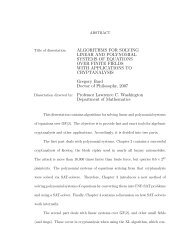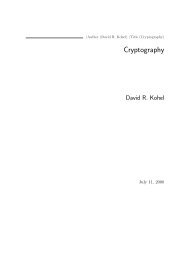- Page 1: Sage Reference Manual: Fixed andArb
- Page 5 and 6: Sage Reference Manual: Fixed and Ar
- Page 7 and 8: CHAPTERONEDOUBLE PRECISION REAL NUM
- Page 9 and 10: Sage Reference Manual: Fixed and Ar
- Page 11 and 12: Sage Reference Manual: Fixed and Ar
- Page 13 and 14: Sage Reference Manual: Fixed and Ar
- Page 15 and 16: Sage Reference Manual: Fixed and Ar
- Page 17 and 18: Sage Reference Manual: Fixed and Ar
- Page 19: Sage Reference Manual: Fixed and Ar
- Page 23 and 24: Sage Reference Manual: Fixed and Ar
- Page 25 and 26: Sage Reference Manual: Fixed and Ar
- Page 27 and 28: Sage Reference Manual: Fixed and Ar
- Page 29 and 30: CHAPTERTWOARBITRARY PRECISION REALN
- Page 31 and 32: Sage Reference Manual: Fixed and Ar
- Page 33 and 34: Sage Reference Manual: Fixed and Ar
- Page 35 and 36: Sage Reference Manual: Fixed and Ar
- Page 37 and 38: Sage Reference Manual: Fixed and Ar
- Page 39 and 40: Sage Reference Manual: Fixed and Ar
- Page 41 and 42: Sage Reference Manual: Fixed and Ar
- Page 43 and 44: Sage Reference Manual: Fixed and Ar
- Page 45 and 46: Sage Reference Manual: Fixed and Ar
- Page 47 and 48: Sage Reference Manual: Fixed and Ar
- Page 49 and 50: Sage Reference Manual: Fixed and Ar
- Page 51 and 52: Sage Reference Manual: Fixed and Ar
- Page 53 and 54: Sage Reference Manual: Fixed and Ar
- Page 55 and 56: Sage Reference Manual: Fixed and Ar
- Page 57 and 58: Sage Reference Manual: Fixed and Ar
- Page 59 and 60: Sage Reference Manual: Fixed and Ar
- Page 61 and 62: Sage Reference Manual: Fixed and Ar
- Page 63 and 64: Sage Reference Manual: Fixed and Ar
- Page 65 and 66: Sage Reference Manual: Fixed and Ar
- Page 67 and 68: Sage Reference Manual: Fixed and Ar
- Page 69 and 70: Sage Reference Manual: Fixed and Ar
- Page 71 and 72:
Sage Reference Manual: Fixed and Ar
- Page 73 and 74:
CHAPTERTHREEARBITRARY PRECISION REA
- Page 75 and 76:
Sage Reference Manual: Fixed and Ar
- Page 77 and 78:
Sage Reference Manual: Fixed and Ar
- Page 79 and 80:
Sage Reference Manual: Fixed and Ar
- Page 81 and 82:
Sage Reference Manual: Fixed and Ar
- Page 83 and 84:
Sage Reference Manual: Fixed and Ar
- Page 85 and 86:
Sage Reference Manual: Fixed and Ar
- Page 87 and 88:
Sage Reference Manual: Fixed and Ar
- Page 89 and 90:
Sage Reference Manual: Fixed and Ar
- Page 91 and 92:
Sage Reference Manual: Fixed and Ar
- Page 93 and 94:
Sage Reference Manual: Fixed and Ar
- Page 95 and 96:
Sage Reference Manual: Fixed and Ar
- Page 97 and 98:
Sage Reference Manual: Fixed and Ar
- Page 99 and 100:
Sage Reference Manual: Fixed and Ar
- Page 101 and 102:
Sage Reference Manual: Fixed and Ar
- Page 103 and 104:
Sage Reference Manual: Fixed and Ar
- Page 105 and 106:
CHAPTERFOURFIELD OF ARBITRARY PRECI
- Page 107 and 108:
CHAPTERFIVEFILE:SAGE/RINGS/REAL_INT
- Page 109 and 110:
Sage Reference Manual: Fixed and Ar
- Page 111 and 112:
Sage Reference Manual: Fixed and Ar
- Page 113 and 114:
CHAPTERSIXTHESE CLASSES ARE VERY LA
- Page 115 and 116:
Sage Reference Manual: Fixed and Ar
- Page 117 and 118:
Sage Reference Manual: Fixed and Ar
- Page 119 and 120:
Sage Reference Manual: Fixed and Ar
- Page 121 and 122:
Sage Reference Manual: Fixed and Ar
- Page 123 and 124:
CHAPTERSEVENDOUBLE PRECISION COMPLE
- Page 125 and 126:
Sage Reference Manual: Fixed and Ar
- Page 127 and 128:
Sage Reference Manual: Fixed and Ar
- Page 129 and 130:
Sage Reference Manual: Fixed and Ar
- Page 131 and 132:
Sage Reference Manual: Fixed and Ar
- Page 133 and 134:
Sage Reference Manual: Fixed and Ar
- Page 135 and 136:
Sage Reference Manual: Fixed and Ar
- Page 137 and 138:
Sage Reference Manual: Fixed and Ar
- Page 139 and 140:
Sage Reference Manual: Fixed and Ar
- Page 141 and 142:
CHAPTEREIGHTFIELD OF ARBITRARY PREC
- Page 143 and 144:
Sage Reference Manual: Fixed and Ar
- Page 145 and 146:
Sage Reference Manual: Fixed and Ar
- Page 147 and 148:
CHAPTERNINEARBITRARY PRECISION COMP
- Page 149 and 150:
Sage Reference Manual: Fixed and Ar
- Page 151 and 152:
Sage Reference Manual: Fixed and Ar
- Page 153 and 154:
Sage Reference Manual: Fixed and Ar
- Page 155 and 156:
Sage Reference Manual: Fixed and Ar
- Page 157 and 158:
Sage Reference Manual: Fixed and Ar
- Page 159 and 160:
Sage Reference Manual: Fixed and Ar
- Page 161 and 162:
Sage Reference Manual: Fixed and Ar
- Page 163 and 164:
Sage Reference Manual: Fixed and Ar
- Page 165 and 166:
CHAPTERTENARBITRARY PRECISION COMPL
- Page 167 and 168:
Sage Reference Manual: Fixed and Ar
- Page 169 and 170:
Sage Reference Manual: Fixed and Ar
- Page 171 and 172:
Sage Reference Manual: Fixed and Ar
- Page 173 and 174:
Sage Reference Manual: Fixed and Ar
- Page 175 and 176:
Sage Reference Manual: Fixed and Ar
- Page 177 and 178:
Sage Reference Manual: Fixed and Ar
- Page 179 and 180:
Sage Reference Manual: Fixed and Ar
- Page 181 and 182:
CHAPTERELEVENFIELD OF ARBITRARY PRE
- Page 183 and 184:
Sage Reference Manual: Fixed and Ar
- Page 185 and 186:
Sage Reference Manual: Fixed and Ar
- Page 187 and 188:
CHAPTERTWELVEARBITRARY PRECISION CO
- Page 189 and 190:
Sage Reference Manual: Fixed and Ar
- Page 191 and 192:
Sage Reference Manual: Fixed and Ar
- Page 193 and 194:
Sage Reference Manual: Fixed and Ar
- Page 195 and 196:
Sage Reference Manual: Fixed and Ar
- Page 197 and 198:
CHAPTERTHIRTEENINDICES AND TABLES
- Page 199 and 200:
PYTHON MODULE INDEXrsage.rings.comp
- Page 201 and 202:
INDEXAabs() (sage.rings.complex_dou
- Page 203 and 204:
Sage Reference Manual: Fixed and Ar
- Page 205 and 206:
Sage Reference Manual: Fixed and Ar
- Page 207 and 208:
Sage Reference Manual: Fixed and Ar
- Page 209 and 210:
Sage Reference Manual: Fixed and Ar
- Page 211 and 212:
Sage Reference Manual: Fixed and Ar
- Page 213 and 214:
Sage Reference Manual: Fixed and Ar
















